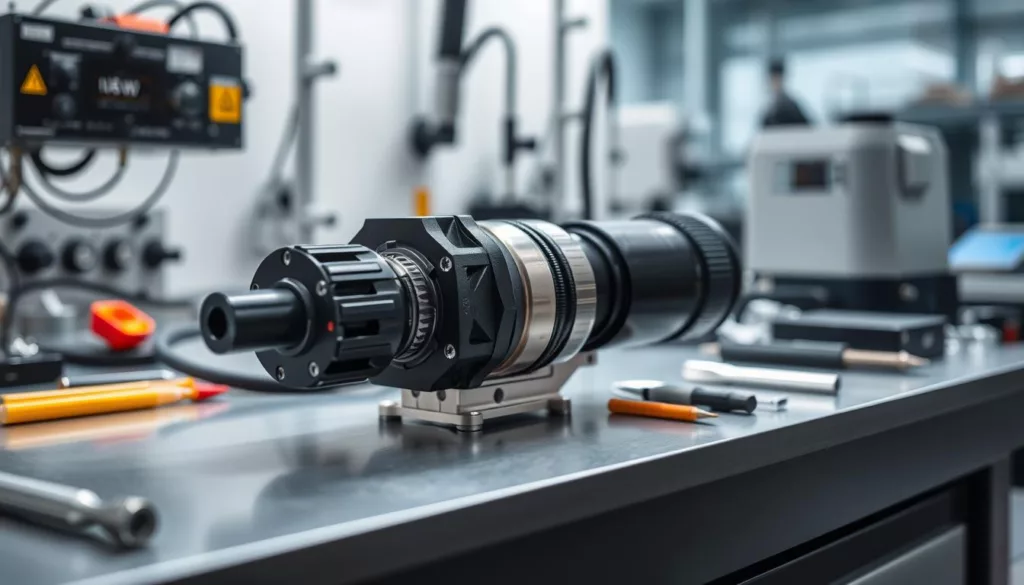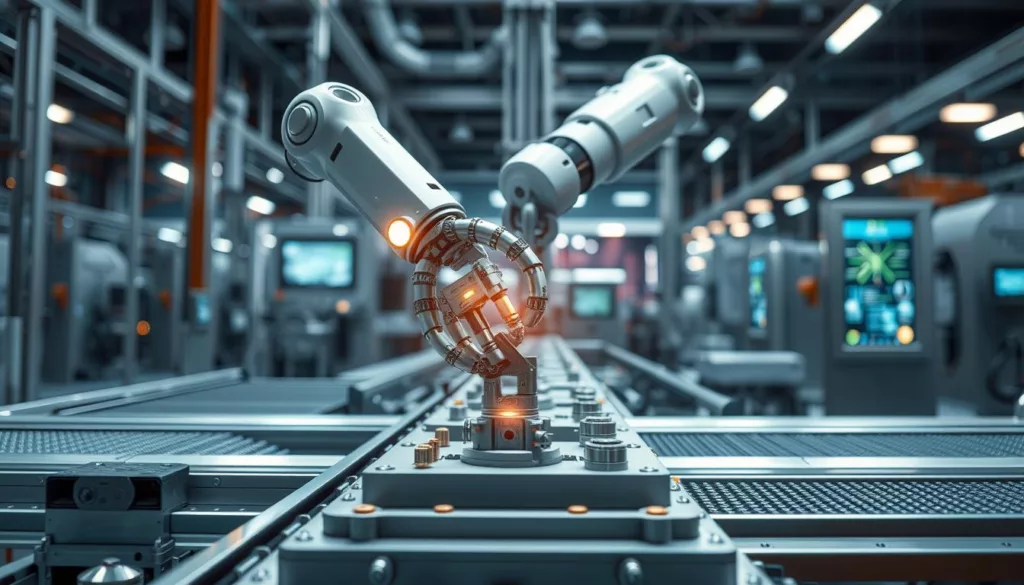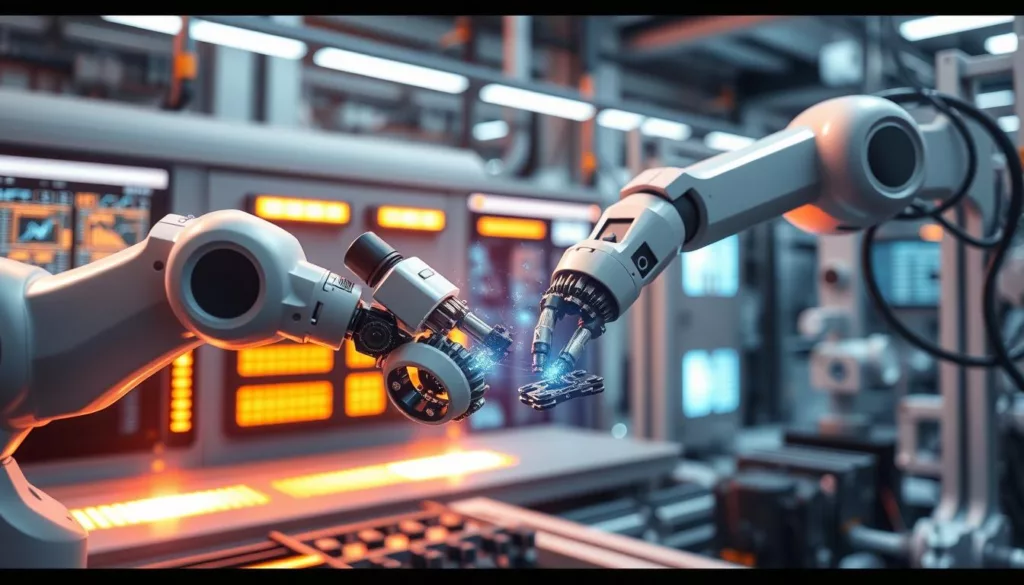In today’s fast-paced world of robotics and automation, precision is key. Advanced 6 axis force torque sensors are at the core of this precision. They help robots move accurately and respond quickly. These sensors measure forces and torques in multiple directions, vital for tasks from surgery to fast assembly lines.
The need for better robotic systems is growing fast. This means finding reliable force torque sensors is more urgent than ever. Companies are looking for the best 6 axis force torque sensors for their needs. We’ll look at the top sensors available, focusing on their features, performance, and uses in industry.
Key Takeaways
- 6 axis force torque sensors are essential for precise robotic control and industrial automation applications
- These sensors measure forces and torques along multiple axes, enabling advanced motion control and feedback
- Manufacturers are constantly seeking the best 6 axis force torque sensors to meet the increasing demands of their applications
- Factors such as accuracy, resolution, repeatability, and data processing capabilities are critical in selecting the right sensor solution
- Understanding the key features and performance characteristics of top 6 axis force torque sensors is essential for making informed purchasing decisions
Understanding Force Torque Sensors in Modern Robotics
In the world of industrial automation, multi-axis load cells and force-torque measurement systems are key. They help with precision control and advanced robotics. These sensors measure forces and torques on different axes, giving important feedback for many uses.
Basic Principles of Multi-Axis Force Sensing
Multi-axis force sensing works by detecting forces and torques on multiple axes at once. This is done with strain gauges or other sensing tech. They measure small changes and stresses in the sensor’s parts.
Key Components and Architecture
A force torque sensor has a mechanical part, like a six-axis load cell, and an electronics module. The module handles signal processing and digital conversion. Together, they capture and understand force and torque data, helping with control and feedback in industrial automation sensors.
Applications in Industrial Automation
Force torque sensors are used in many fields, like robotics and material testing. They help with tasks like object handling and assembly checks. This ensures high performance and quality in today’s industrial settings.
“Force torque sensors are the unsung heroes of industrial automation, enabling precision, efficiency, and safety in a wide range of applications.”
Best 6 Axis Force Torque Sensors for Precision Control
For precise control in robotics and industry, accurate force feedback is key. The top 6 axis force torque sensors offer high performance and versatility.
The XJCSENSOR XFC-6100 is a top pick. It’s small and tough, giving high-accuracy force feedback up to 1000 N. Its advanced tech ensures reliable data, perfect for assembly and quality checks.
| Sensor Model | Measurement Range | Accuracy | Overload Capacity | Interfaces |
|---|---|---|---|---|
| XJCSENSOR XFC-6100 | ±1000 N | ±0.2% FS | 300% | Analog, Ethernet, EtherCAT |
| ATI Nano17 | ±35 N | ±0.1% FS | 150% | Analog, USB, Ethernet |
| OptoForce HEX-70-20 | ±70 N | ±0.5% FS | 200% | Analog, USB, Ethernet |
The ATI Nano17 is another great choice. It’s small and light, with precision force torque monitoring up to 35 N. It’s perfect for robotic assembly and more.
The OptoForce HEX-70-20 is good for bigger ranges. It uses optical tech for precision force torque monitoring up to 70 N. Ideal for robotic tasks and force control.
“The ability to accurately measure and control forces in robotic and industrial applications is critical for precise and efficient operations.”
These sensors are just a few examples of top 6 axis force torque sensors. Choose the right one for your needs in high-accuracy force feedback and precision force torque monitoring.
Advanced Technologies in Force-Torque Measurement
Robotic assembly and industrial automation are getting better. Now, we need precise and reliable force-torque sensing more than ever. New technologies are changing how we measure force and torque, making robots more precise and controlled.
Strain Gauge Technology
Strain gauges are key in force-torque sensing. They measure tiny changes in the sensor, giving us accurate force and torque readings. New designs and signal processing make these gauges super sensitive, detecting even small forces.
Optical Sensing Methods
Optical sensing is also important in robotic assembly force sensing. It uses light to measure forces and torques with great accuracy. Optical sensors, like fiber-optic and interferometric ones, work well in tough environments because they’re not affected by electromagnetic interference.
Digital Signal Processing Innovations
Digital signal processing (DSP) has made big leaps. Now, microprocessors and algorithms can analyze sensor data in real-time. This makes robotic assembly force sensing systems more accurate and quick. These advancements help improve control and precision in industrial automation.
Thanks to these advanced technologies, manufacturers and system integrators can achieve better performance and reliability. This boosts productivity and quality in robotic assembly operations.
Precision Requirements for Industrial Applications
In the world of industrial automation, precision is key. From surgery to manufacturing, industries need sensors that can measure tiny changes in force and torque. This section looks at what makes top-tier force-torque sensors so important.
Precise robotic control is vital for quality, efficiency, and safety. Cutting-edge force-torque sensors can spot small changes in force. This helps robots do complex tasks with great accuracy. It’s critical in aerospace, automotive, and electronics, where small errors can be big problems.
High-accuracy force feedback changes quality control. These sensors give real-time data on forces, helping manufacturers keep standards high. This is key in making medical devices and food, where quality is everything.
| Industry Sector | Precision Requirements |
|---|---|
| Aerospace | Micron-level positional accuracy, sub-Newton force resolution |
| Automotive | Nanometer-scale position control, milli-Newton force sensitivity |
| Electronics | Submicron displacement tracking, micro-Newton force detection |
| Medical Devices | Micrometer-precise positioning, milli-Newton force monitoring |
As automation and quality control advance, so does the need for better sensors. Investing in these technologies will help manufacturers stay ahead in the next wave of innovation.
Integration Challenges and Solutions
Adding robotic force sensing and industrial automation sensors to industrial settings can be tricky. You need to think about hardware, software, and calibration. Each part must be carefully looked at to make sure everything works well together.
Hardware Integration Considerations
Choosing the right 6 axis force torque sensor is key. You should consider size, mounting, and cable management. Talking to sensor experts can help find the best fit for your needs.
Software Compatibility Issues
Getting sensor data to work with your systems and software takes planning. You need to make sure everything talks the same language. Working with both sensor and software companies can make this easier.
Calibration Requirements
Getting accurate force and torque measurements is critical. A good calibration routine is vital. It keeps your sensors precise and your data reliable. Knowing what calibration your sensors need is important for accurate results.
“Proactive planning and collaboration with sensor experts can help overcome integration challenges and unlock the full industrial automation sensors.”
Performance Metrics and Evaluation Criteria
When picking the best precision force torque monitoring solution, it’s key to check the performance of multi-component force transducers. This detailed check ensures the sensor fits your application’s needs, in fields like automotive, industrial, or aerospace.
Here are the main performance factors to look at:
- Accuracy: The sensor’s ability to give precise, reliable data is essential. Look for models with low error rates and great repeatability.
- Resolution: Find out the smallest change the sensor can detect. This affects the quality of your data and control.
- Sensitivity: Check how well the sensor responds to forces. It should catch even small changes in your measurements.
- Overload Capacity: Know the sensor’s max load it can handle. This ensures it can meet your application’s demands without losing performance.
- Bandwidth: See if the sensor can handle high-frequency events. This is key for real-time data analysis in your application.
- Robustness: Make sure the sensor can handle environmental factors like temperature, vibration, and shock. It should keep performing well.
By carefully looking at these metrics, you can pick the precision force torque monitoring solution that fits your needs best. This improves process control, safety, and overall system performance.
| Performance Metric | Importance | Evaluation Criteria |
|---|---|---|
| Accuracy | High | Minimize error rates and maximize repeatability |
| Resolution | High | Determine the smallest detectable change |
| Sensitivity | High | Assess responsiveness to applied forces |
| Overload Capacity | Medium | Understand the sensor’s maximum load-bearing capacity |
| Bandwidth | High | Evaluate the sensor’s ability to capture high-frequency dynamic events |
| Robustness | High | Ensure the sensor can withstand environmental factors without performance degradation |
“Choosing the right multi-component force transducer is key for top process control and system performance. By carefully checking the key performance metrics, you can find the sensor that best meets your application’s needs.”
Cost-Benefit Analysis of High-End Sensors
Choosing the right 6 axis force torque sensors is key for precision and automation. It’s important to look at the costs and benefits. This helps in making smart choices that balance upfront costs with future gains and upkeep.
Initial Investment Considerations
Top-notch 6 axis force torque sensors cost more than basic ones. But, their advanced features and abilities can make the extra cost worth it. Think about accuracy, resolution, sensitivity, and how well they fit with your systems.
Long-term ROI Factors
- Increased process efficiency and productivity
- Improved product quality and reduced waste
- Enhanced safety and risk mitigation
- Reduced maintenance and downtime
- Longer sensor lifespan and reliability
Maintenance and Calibration Costs
High-end sensors might cost more upfront, but they could save money in the long run. Consider these points:
| Metric | High-End Sensors | Basic Sensors |
|---|---|---|
| Calibration Frequency | Less frequent | More frequent |
| Sensor Lifespan | Longer | Shorter |
| Maintenance Requirements | Less intensive | More intensive |
By looking at the costs, benefits, and upkeep, you can choose the best 6 axis force torque sensors. This is for your precision and automation needs.
Future Trends in Force Torque Sensing Technology
The world of robotic force sensing is set to see big changes. We’ll see new designs, materials, and ways to process data. These will open up new areas for robotic force sensing and precision robotic control.
Sensor Design Innovations
New materials and MEMS tech could make sensors better. They might be more sensitive, quick, and small. We might see sensors that work better in tough environments.
Breakthroughs in Data Processing
Combining sensors with smart algorithms and AI will change how robots work. They’ll understand force and torque data better. This could lead to robots that work smarter and safer in changing settings.
Towards Intelligent, Autonomous Systems
Force sensing, machine learning, and AI will create smarter robots. These robots will learn, adapt, and work well with people. They’ll change what’s possible in precision robotic control.
“The future of force torque sensing lies in its ability to enable robots to interact with their environment with greater dexterity and situational awareness, unlocking new realms of industrial automation and human-robot collaboration.”
As we explore new limits, force torque sensing will become key. It will help unlock the full power of robotic force sensing and precision robotic control.
Conclusion
Choosing the best 6 axis force torque sensors is key for precise control and measurement. These sensors use advanced technologies for high accuracy and reliability. They are essential in many industrial settings.
We’ve looked at how these sensors work and their uses in robotics and automation. Knowing about strain gauge technology, optical sensing, and digital signal processing helps professionals choose the right sensors. This knowledge is vital for making smart decisions in industrial operations.
Choosing the right 6 axis force torque sensor depends on specific needs and performance. It’s important to consider the cost, long-term benefits, and maintenance needs. This way, companies can make the most of these sensors in their work.





